Lemons are often used in a variety of drinks and meals to add a tangy flavor. The skin of the lemon is rich in essential oils, giving it a unique scent. It is widely favored as an addition to all sorts of cocktails, sweets, and countless other dishes. That said, not many people know the proper way to zest a lemon efficiently. If you’re curious about how to zest a lemon effectively, join us as we are eager to show you the best techniques for zesting a lemon!
What Is Lemon Zest?
Lemon zest is the outermost layer of a lemon (which can be yellow or green) that is cut with a knife or removed by slicing.
The flavor of zest lemon is really strong, it can enhance the flavor of certain foods in some dishes. Besides, it is also extremely loved by many people to add lemon zest to their drinks.
Lemon peel contains a lot of essential oils, so lemon peel is mainly used to create flavor. It has a mild bitter taste and is not as sour as the citrus part of a lemon.
How to Zest a Lemon?
Lemon peel is a favorite ingredient in many of their recipes. However, zest a lemon is actually a bit difficult because the skin of the lemon is very thin.
Many different ways of zest a lemon have been devised. Here are some ways to zest a lemon that we want to share with you:
- Zest a lemon with a peeler
- Zest a lemon with a knife
- Zest a lemon with a box scraper
- Zest a lemon is equal to Citrus Zester
- Zest a lemon with Microplane
1. Zest a lemon with a peeler
This peeler is bound to be in any kitchen. Instead of using them to peel vegetables like usual, you can use a peeler to zest a lemon. This method will give you thin slices of lemon zest.
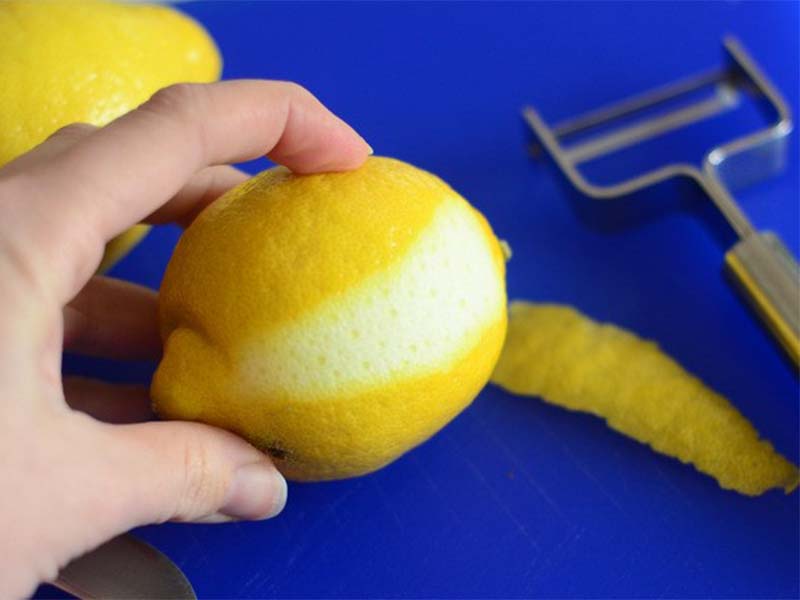
Doing:
- Place the sharp edge of the peeler on one end of the lemon, pressing in gently to create a starting point.
- Gently pull down the other end of the lemon. Should pull with a moderate force, avoid peeling the white pulp along. The less white part that sticks to the peeled lemon, the better.
- Repeat this process in turn until the outer skin of the lemon is gone.
- If you tried, but the peeled zest lemon still has a lot of white pulp. Take the knife and filter the white pulp. Then finely chop the lemon zest to make zest lemon.
2. Zest a lemon with a knife
Knives are probably the most familiar tool of all kitchens. You can be without a spice jar, but not without a knife. This familiar kitchen tool will help you zest a lemon. The way of the knife will be similar to the way you use a peeler. But it will be complicated and need a little more technique.
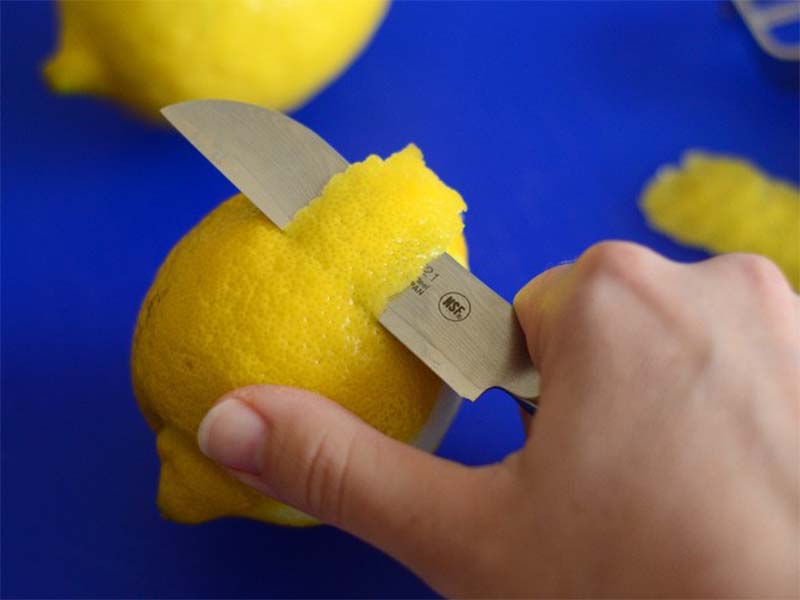
Doing:
- First, cut off one end of the lemon, placing the cut side of the lemon in contact with the cutting board.
- Gently slide the knife to cut along the corners of the fruit in the top-down direction. Cut from the top end to the bottom end. Remember to cut carefully and thinly, avoiding cutting the white pulp along the yellow skin.
- Cut off the white parts that stick to the yellow crust. Chop the lemon zest to make zest lemon.
If you don’t want to cut one end of the lemon for a vertical cut, you can fix the lemon horizontally on a cutting board and peel the peel in a circle around the fruit.
3. Zest a lemon with a box scraper
The canister is a tool that can help you zest a lemon effectively. It will give you soft lemon zest. When using this tool you also need to pay attention to rotating the lemon continuously. You should gently press the lemon to get the bright yellow outer skin, do not scrape the white pulp inside.
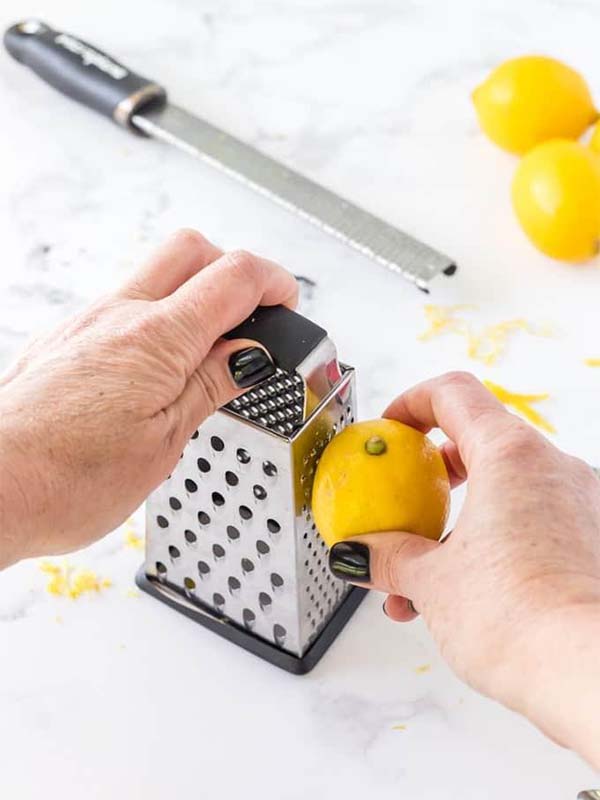
- Place the box scraper on top of the cutting board and secure it with one hand. Your other hand holds a lemon.
- Hold the lemon and push it through the rough, porous surface of the canister. Gently push your hand to get the best lemon zest.
- Turn the other side of the lemon and keep pushing until all the yellow or green skin is removed.
- Collect the grated lemon peel and chop it to make zest lemon.
When using this tool you need to pay attention to the peel of the lemon after each push. Avoid the case that the outside of the lemon is only white, at this point you should not continue to push, switch to the other side.
4. Zest a lemon is equal to Citrus Zester
Citrus Zester is an orange peeler that is very familiar to chefs or baristars. When you use this tool you will get long, thin and beautiful strips of lemon peel. This can be considered the standard tool for making zest lemon.
Citrus Zester helps you create beautiful zest lemon to decorate cakes or cocktails. If you have high aesthetic requirements in food or want to use zest lemon for decoration, this lemon peeler is perfect for you.
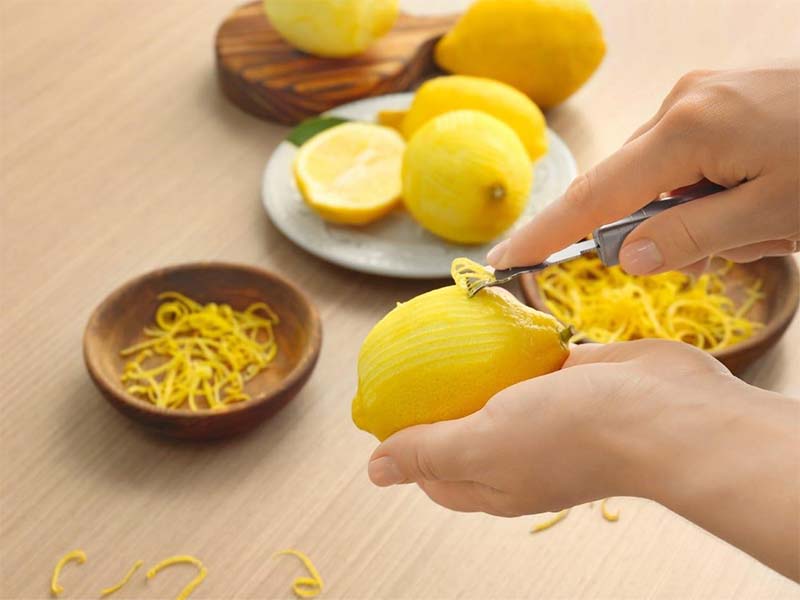
- You hold a lemon in one hand and a Citrus Zester in the other (a small suggestion for you is whether you should hold the Citrus Zester in your hand or hold a knife)
- Place small holes in the pointed Citrus Zester up to one end of a lemon. You can place it near the stem of the lemon.
- Gently press down on the lemon and pull down the curve of the fruit to the other end.
- Repeat the process until all the lemon peels are yellow. Do not continue with the white pulp.
- Collect the zest lemons you just shaved off.
5. Zest a lemon with Microplane
Microplane is the most popular lemon peeler. It will give you the perfect zest lemon with lots of grated lemon zest.
This tool is very convenient and easy to use, it only takes a few minutes to get the perfect zest lemon. However, you need to be careful when using the Microplane, your hands should not touch the metal surface when scraping the lemon peel. This metal surface has a lot of small sharp holes, it can hurt your hand.
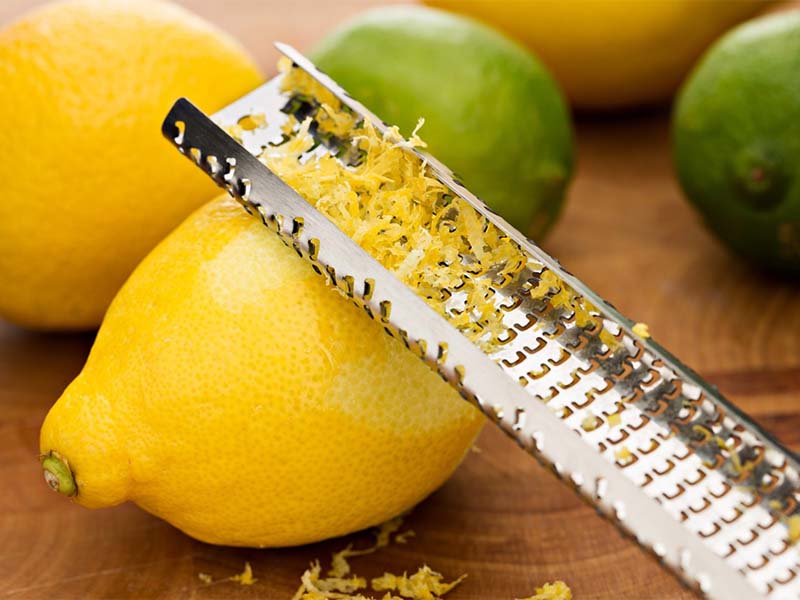
- Holding a lemon in one hand and a Microplane in the other.
- Place the lemon on the mesh surface and push it back and forth, the rough surface on the mesh will help you peel the lemon. Rotate the lemon evenly so as not to scrape the white pulp.
- Continue doing this until the outermost layer of lemon peel is gone.
- Tap the grid to release the zest lemons and collect them to use in your recipes.
How to Wash Lemon Peel?
Many farms and suppliers often use preservatives or waxes to preserve lemons. Of course they will not be beneficial for your health. Either way you zest a lemon, you must wash its skin. Here are a few ways to clean the peel we recommend for you:
With a lemon that doesn’t want to remove the wax
With lemons that do not have a waxy outer layer, you can wash the lemon peel with salt. Use powdered salt to rub gently with lemon peel to remove chemicals. Do not rub too hard, you will cause the essential oil in the lemon peel to escape. Gently rub and rinse with clean water.
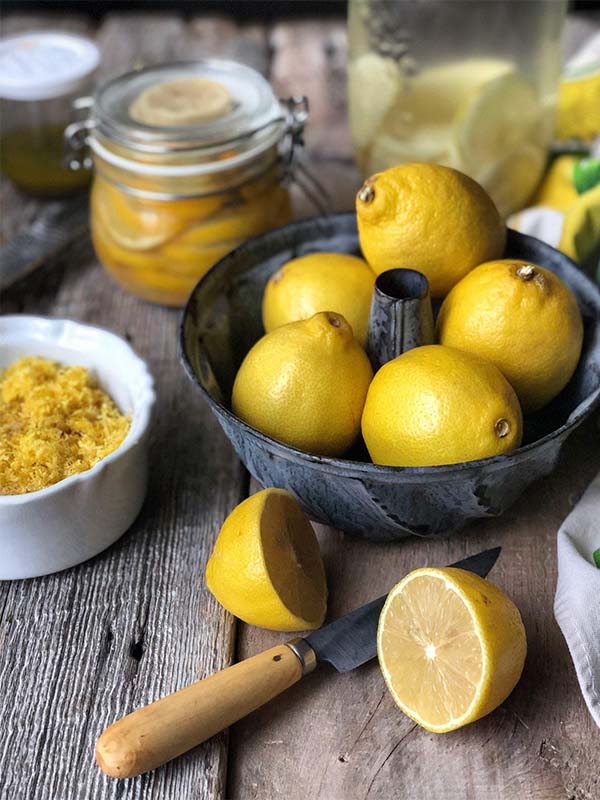
With a lemon that want to remove the wax
The wax on the outside of the lemon can be eaten, but if you want to remove it, you can follow these steps:
Bring a pot of water to a boil and then add the lemon, or just put the lemon in for a split second, submerge the lemon in the pot of water and then take it out immediately. Don’t leave it too long, your lemon will ripen.
Use a brush with very soft bristles to scrub the lemon peels right away. Scrub until the wax is completely removed. Because it has been soaked in hot water, the wax is easy to remove.
Rinse the lemon with clean water and pat dry.
Tips to Help You Have the Perfect Zest Lemon
- If the lemon is too soft to peel, put the lemon in the freezer for about 2 minutes to harden.
- It is best to choose lemon peels that are light in color and have a strong aroma when scratched on the peel. Thin-skinned lemons like orange-leaf lemons can be difficult to grate.
- If you don’t want to have to wash the grater, you can try placing a layer of plastic or parchment paper between the microplane and the lemon as you grate. However, this may cause the nylon or paper to tear, so use good materials.
- If you are using both lemon zest and lemon juice, grate the zest before squeezing the juice.
- You can put the peeled lemons in the fridge and squeeze the juice later. Cover the lemons with cling film to keep them from drying out.
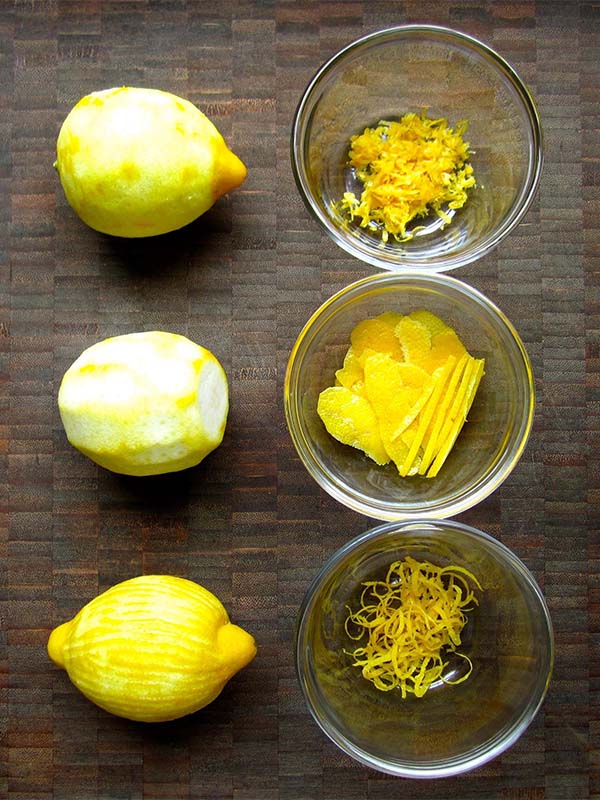
Neutralizes free radicals
Free radicals are known to be one of the causes of aging and many types of cancer. They damage cell membranes and cause strong reactions with proteins, fatty acids and DNA, leading to cell changes (damage, disorder, and even death).
Thanks to the high content of vitamin C, lemon peel is considered a food capable of neutralizing free radicals as well as preventing problems related to aging and cancer.
Supports strong bones
Lemon peel is also rich in calcium besides vitamin C, so consuming lemon peel has also been shown to be beneficial in supporting strong bones and preventing bone disorders like osteoporosis, polyarthritis, arthritis. rheumatoid arthritis or osteoarthritis.
Cancer Prevention
Lemon peels also contain salvestrol Q40 and limonene compounds, which have anti-cancer effects. In addition, another active ingredient called flavonoid is also effective when it comes to slowing down the division of cancer cells, especially skin cancer, breast cancer, and colon cancer.
Lemon peel repels insects and cleans microwaves
You can put lemon peels in the corner of the kitchen or where insects (like ants) often appear. Because the essential oil in the lemon peel will make them no longer want to hang around in those areas.
Thanks to the amount of acid secreted from the lemon peel, when you use lemon peel vinegar or simply soak the lemon peel in warm water to dissolve the essence, then use this solution to clean the microwave for a long time.
Alternatively, you can put the lemon peel in a bowl of water, then put it in the microwave on a high temperature for about 5 minutes so that the acid in the lemon peel evaporates and loosens stubborn stains on the inside of the oven.
Final Words
Zest lemon can be used for many different recipes. It will make your dishes or drinks more distinctive. You can zest a lemon in many different ways. We have shared with you the fastest and most effective tips on how to zest a lemon. Hopefully, the above sharing can help make your recipe more perfect!
